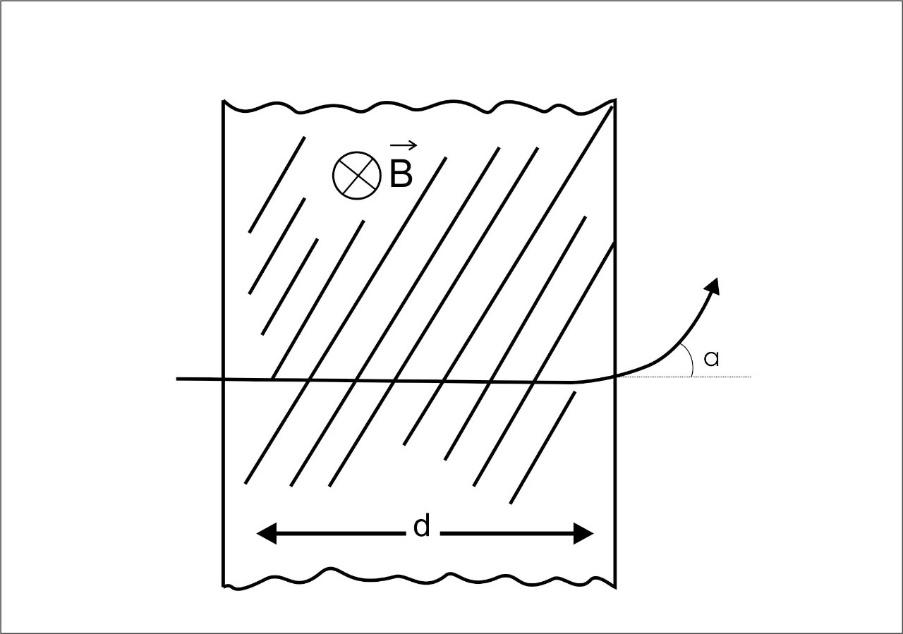
A proton (mass m) accelerated by a potential difference V files through a uniform transverse magnetic field B. The field occupies a region of space by width ‘d’. If $\alpha $ be the angle of deviations of proton from initial direction of motion (see fig), the value of $\sin \alpha $ will be:

A) $Bd\sqrt {\dfrac{q}{{2mV}}} $
B) $\dfrac{B}{d}\sqrt {\dfrac{{qd}}{{mV}}} $
C) $qV\sqrt {\dfrac{{Bd}}{{2m}}} $
D) $\dfrac{B}{d}\sqrt {\dfrac{q}{{2mV}}} $
Answer
138.9k+ views
Hint: In this question, first we have to calculate energy of proton $E$ in the term of $v$ , and then have to find the magnetic force $F$. From the given figure we can easily find that $\sin \alpha = \dfrac{d}{R}$ . After putting the value of $R$ we can easily find the value of $\sin \alpha $.
Complete step by step answer:
In this question, A proton (mass m) is accelerated by a potential difference V files through a uniform transverse magnetic field B, and the field occupies a region of space by width ‘$d$ ’. Here, $\alpha $ be the angle of deviation of proton from initial direction of motion .we need to calculate, the value of $\sin \alpha $.
Given that,
$m = $ Mass of proton
$V = $ Potential difference
$v = $ Velocity of proton
$e = $ Charge on proton
$d = $ The field occupies a region of space of width.
$R = $ The radius of circle
$\alpha = $ Angle of deviation
Now, first we have to find the energy of proton,
We know that,
$ E = \dfrac{1}{2}m{v^2} = eV$
Hence,
$\Rightarrow v = \sqrt {\dfrac{{2eV}}{m}} $
Now find the magnetic force, we know that magnetic force can be written as,
\[\Rightarrow F = e\left( {\overrightarrow v \times \overrightarrow B } \right)\]
$ \Rightarrow \dfrac{{m{v^2}}}{R} \\
\Rightarrow R = \dfrac{{mv}}{{eB}} \\ $
We know that,
$\Rightarrow \sin \alpha = \dfrac{d}{R}$
On putting the value of$R$, we get
$\Rightarrow \sin \alpha = \dfrac{{deB}}{{mv}} \\
\Rightarrow \sin \alpha = \dfrac{{deB}}{m}\sqrt {\dfrac{m}{{2eV}}} \\
\Rightarrow \sin \alpha = Bd\sqrt {\dfrac{e}{{2mV}}} \\ $
$e$ can be written as $q$, which is the symbol of charge, thus the equation become, $\sin \alpha = Bd\sqrt {\dfrac{q}{{2mV}}} $
Therefore, the correct option is A.
Note: As we know that the force is the vector quantity and the cross product of the velocity and the magnetic field provide the vector quantity. And we know the correct value of $R$ is obtained as $\sin \alpha = \dfrac{d}{R}$.
Complete step by step answer:
In this question, A proton (mass m) is accelerated by a potential difference V files through a uniform transverse magnetic field B, and the field occupies a region of space by width ‘$d$ ’. Here, $\alpha $ be the angle of deviation of proton from initial direction of motion .we need to calculate, the value of $\sin \alpha $.
Given that,
$m = $ Mass of proton
$V = $ Potential difference
$v = $ Velocity of proton
$e = $ Charge on proton
$d = $ The field occupies a region of space of width.
$R = $ The radius of circle
$\alpha = $ Angle of deviation
Now, first we have to find the energy of proton,
We know that,
$ E = \dfrac{1}{2}m{v^2} = eV$
Hence,
$\Rightarrow v = \sqrt {\dfrac{{2eV}}{m}} $
Now find the magnetic force, we know that magnetic force can be written as,
\[\Rightarrow F = e\left( {\overrightarrow v \times \overrightarrow B } \right)\]
$ \Rightarrow \dfrac{{m{v^2}}}{R} \\
\Rightarrow R = \dfrac{{mv}}{{eB}} \\ $
We know that,
$\Rightarrow \sin \alpha = \dfrac{d}{R}$
On putting the value of$R$, we get
$\Rightarrow \sin \alpha = \dfrac{{deB}}{{mv}} \\
\Rightarrow \sin \alpha = \dfrac{{deB}}{m}\sqrt {\dfrac{m}{{2eV}}} \\
\Rightarrow \sin \alpha = Bd\sqrt {\dfrac{e}{{2mV}}} \\ $
$e$ can be written as $q$, which is the symbol of charge, thus the equation become, $\sin \alpha = Bd\sqrt {\dfrac{q}{{2mV}}} $
Therefore, the correct option is A.
Note: As we know that the force is the vector quantity and the cross product of the velocity and the magnetic field provide the vector quantity. And we know the correct value of $R$ is obtained as $\sin \alpha = \dfrac{d}{R}$.
Recently Updated Pages
Young's Double Slit Experiment Step by Step Derivation

How to find Oxidation Number - Important Concepts for JEE

How Electromagnetic Waves are Formed - Important Concepts for JEE

Electrical Resistance - Important Concepts and Tips for JEE

Average Atomic Mass - Important Concepts and Tips for JEE

Chemical Equation - Important Concepts and Tips for JEE

Trending doubts
JEE Main 2025 Session 2: Application Form (Out), Exam Dates (Released), Eligibility, & More

JEE Main 2025: Derivation of Equation of Trajectory in Physics

Learn About Angle Of Deviation In Prism: JEE Main Physics 2025

Electric Field Due to Uniformly Charged Ring for JEE Main 2025 - Formula and Derivation

JEE Main 2025: Conversion of Galvanometer Into Ammeter And Voltmeter in Physics

Degree of Dissociation and Its Formula With Solved Example for JEE

Other Pages
JEE Advanced Marks vs Ranks 2025: Understanding Category-wise Qualifying Marks and Previous Year Cut-offs

Electric field due to uniformly charged sphere class 12 physics JEE_Main

Physics Average Value and RMS Value JEE Main 2025

Dual Nature of Radiation and Matter Class 12 Notes: CBSE Physics Chapter 11

Formula for number of images formed by two plane mirrors class 12 physics JEE_Main

Charging and Discharging of Capacitor




